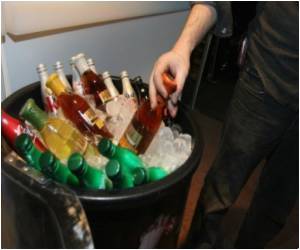Research has indicated that different combinations of food and beverages can influence satiety.

There are reports that these sweetened beverages could increase the gastric volume thereby causing a great deal of discomfort. This has, however, been contradicted by several researchers.
For instance Pouderoux et al. found that there was no difference between 300 ml of both carbonated and still water taken along with a 700 kcal meal with regard to gastric emptying or in the feeling of fullness that it can generate. However the person tends to belch a lot after consuming the carbonated drink.
One study have reported gastric distress and delayed gastric emptying with either water or cola taken during meals. Yet another study has reported increased satiety when carbonated drinks were taken along with food.
It is understood that several factors determine hunger and satiety, including gastrointestinal hormones such as cholecystokinin (CCK) and gherelin.
Subjects
The study was carried out on each subject six times, three times with a standardized solid meal and three times with a standardized liquid meal.
There was an interval of one week between each experiment.
All the beverages were colorless and were stored at 4 degree C and were administered directly from the bottle it was contained in.
Besides carbonated water, the commercial beverage included sweeteners such as aspartame 40 mg/100ml or acesulfame K 40 mg/100 ml; flavors such as lemon and lime aromas (100 mg/100 ml) and acidity regulators such as citric acid 230 mg/100 ml or trisodium citrate 10 mg/100 ml.
The carbon dioxide concentration in the beverage was approximately 3.7 volume when the bottle was opened.
The sequences of the type of meal consumed during the experiments were random.
Methodology
The subjects answered standardized questionnaires with regard to their perceptions about eating and satiety. They were made to fast overnight and examined for any gastric illnesses.
The subjects had to drink the 300 ml beverage (water, non-carbonated or carbonated beverage) in 3 minutes, eat the meal (either solid or liquid) at an established rate until they felt totally satiated. Then a gastric magnetic resonance and a hormonal assay were carried out to determine total gastric volumes (TGV) at maximum satiety (MS) on the subjects at established intervals.
Discussion
There was a clear increase in gastric volume immediately after the individual consumed carbonated beverage (without considering food intake). This was considered to be due to the gas in the beverage.
The study revealed that in a normal person, carbon dioxide at its maximum concentration (3.7 volume) contained in a 300 ml of carbonated sweetened beverage, consumed 3 min before a meal, did not diminish satiety or food intake compared to the intake of still water or decarbonated beverage.
Besides carbonated drinks did not influence the amount of solid or liquid food consumed unless the levels consumed exceeded 300 ml.
Also the liquid meal was more satiating probably due to its consistency.
Interestingly, the carbonated beverages and the consistency of meals seem to have an influence on ghrelin release.
More research is required in this area to establish whether different combinations of food and beverages can influence satiety.
Reference: “The role of a pre-load beverage on gastric volume and food intake: comparison between non-caloric carbonated and non-carbonated beverage”;Rosario et al; BMJ Nutrition 2011.
Source-Medindia















